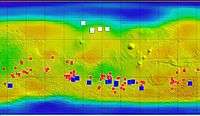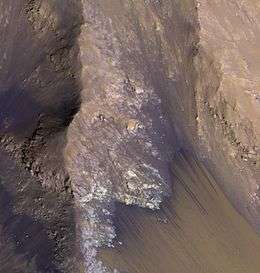Seasonal flows on warm Martian slopes

Seasonal flows on warm Martian slopes (also called recurring slope lineae, recurrent slope lineae and RSL)[1][2] are thought to be salty water flows occurring during the warmest months on Mars.
The flows are narrow (0.5 to 5 meters) and exhibit relatively dark markings on steep (25° to 40°) slopes, appear and incrementally grow during warm seasons and fade in cold seasons. Liquid brines near the surface almost certainly explain this activity,[3] but the exact source of the water and the mechanism behind its motion are not understood. On October 5, 2015, possible RSLs were reported on Mount Sharp near the Curiosity rover.[2]
Overview
Research indicates that in the past there was liquid water flowing on the surface of Mars,[4][5] creating large areas similar to Earth's oceans.[6][7][8][9] However, the question remains as to where the water has gone.[10]
The Mars Reconnaissance Orbiter (MRO) is a multipurpose spacecraft launched in 2005 designed to conduct reconnaissance and exploration of Mars from orbit.[11] The spacecraft is managed by the Jet Propulsion Laboratory (JPL).[12] The HiRISE instrument is at the forefront of the ongoing RSL studies as it helps chart the features with images of closely monitored sites typically taken every few weeks.[13]
Features
.gif)
Distinctive properties of recurring slope lineae (RSL) include slow incremental growth, formation on warm slopes in warm seasons, and annual fading and recurrence,[14] showing a strong correlation with solar heating.[14] RSL extend down slope from bedrock outcrops often following small gullies about 0.5 to 5 meters (1 ft 8 in to 16 ft 5 in) wide, with lengths up to hundreds of meters, and some of the locations display more than 1,000 individual flows.[15][16] RSL advance rates are highest at the beginning of each season, followed by much slower lengthening.[17] RSL appear and lengthen in the late southern spring and summer from 48°S to 32°S latitudes that favor equator-facing slopes, which are times and places with peak surface temperatures from −23 °C to 27 °C. Active RSL also occur in equatorial regions (0–15°S), most commonly in the Valles Marineris troughs.[17]
Researchers surveyed flow-marked slopes with the Mars Reconnaissance Orbiter's CRISM and although there is no spectrographic evidence for actual water,[15] the instrument has now directly imaged perchlorate salts thought to be dissolved in water brines in the subsurface.[3] This may indicate the water quickly evaporates upon reaching the surface, leaving only the salts. The cause of the surface darkening and lightening is poorly understood: a flow initiated by salty water (brine) could rearrange grains or change surface roughness in a way that darkens the appearance, but the way the features brighten again when temperatures drop is harder to explain.[12][18]
Hypotheses
A number of different hypotheses for RSL formation have been proposed. The seasonality, latitude distribution, and brightness changes strongly indicate a volatile material —such as water or liquid CO
2 — is involved. One hypothesis is that RSL could form by rapid heating of nocturnal frost.[14] Another one proposes flows of carbon dioxide, but the settings in which the flows occur are too warm for carbon-dioxide frost (CO
2), and at some sites is too cold for pure water.[14] Other hypotheses include dry granular flows, but no entirely dry process can explain seasonal flows that progressively
grow over weeks and months.[17] Seasonal melting of shallow ice would explain the RSL observations, but it would be difficult to replenish such ice annually.[17] However, recent direct observations of seasonal deposition of soluble salts strongly suggest that RSL are created by a water brine.[3]
Brines
The leading hypothesis involves the flow of brines —very salty water.[3][15][16][19][20][21] Salt deposits over much of Mars indicate that brine was abundant in Mars's past.[12][18] Salinity lowers the freezing point of water to sustain a liquid flow. Less saline water would freeze at the observed temperatures.[12] Thermal infrared data from the Thermal Emission Imaging System (THEMIS) on board the 2001 Mars Odyssey orbiter, have allowed the temperature conditions under which RSL form to be constrained. While a small number of RSL are visible at temperatures above the freezing point of water, most are not, and many appear at temperatures as low as −43 °C (230 K). Some scientists think that under these cold conditions, a brine of iron(III) sulphate (Fe2(SO4)3) or calcium chloride (CaCl
2) is the most likely mode of RSL formation.[22] Another team of scientists, using the CRISM instrument onboard MRO, reported that the evidence for hydrated salts is most consistent with the spectral absorption features of magnesium perchlorate (Mg(ClO4)2), magnesium chloride (MgCl2(H2O)x) and sodium perchlorate (NaClO
4).[3][21]
These observations are the closest scientists have come to finding evidence of liquid water on the planet's surface today.[12][18] Frozen water, however, has been detected near the surface in many middle to high-latitude regions. Purported droplets of brine also appeared on struts of the Phoenix Mars Lander in 2008.[23]
Source of water
Liquid brine flows near the surface might explain this activity, but the exact source of the water and the mechanism behind its motion are not understood.[24][25] A hypothesis proposes that the needed water could originate in the seasonal oscillations of near-surface adsorbed water provided by the atmosphere; perchlorates and other salts known to be present on the surface, are able to attract and hold water molecules from the surrounding environment (hygroscopic salts),[17] but the dryness of the Martian air is a challenge. Water vapor must be efficiently trapped over very small areas, and seasonal variation in the atmospheric column abundance of water vapor does not match the RSL activity over active locations.[14][17]
Deeper groundwater may exist and could reach the surface at springs or seeps,[26][27] but this cannot explain the wide distribution of RSL, extending from the tops of ridges and peaks.[17] Also, there are apparent RSL on equatorial dunes composed of permeable sand, unlikely to be a groundwater source.[17]
Gallery
 Ice (white), salt (red) and warm-season flows (blue) on Mars
Ice (white), salt (red) and warm-season flows (blue) on Mars.gif) Dark flows in Newton Crater extending during summer (video-gif).
Dark flows in Newton Crater extending during summer (video-gif)..gif) Warm season flows on slope in Horowitz Crater (video-gif).
Warm season flows on slope in Horowitz Crater (video-gif). Seasonal flows on Coprates Chasma in Valles Marineris.
Seasonal flows on Coprates Chasma in Valles Marineris.
See also
References
- ↑ Kirby, Runyon; Ojha, Lujendra (August 18, 2014). "Recurring Slope Lineae". Encyclopedia of Planetary Landforms. Retrieved September 26, 2015.
- 1 2 Chang, Kenneth (5 October 2015). "Mars Is Pretty Clean. Her Job at NASA Is to Keep It That Way.". New York Times. Retrieved 6 October 2015.
- 1 2 3 4 5 Ojha, Lujendra; Wilhelm, Mary Beth; Murchie, Scott L.; McEwen, Alfred S.; et al. (28 September 2015). "Spectral evidence for hydrated salts in recurring slope lineae on Mars". Nature Geoscience. doi:10.1038/ngeo2546. Retrieved 2015-09-28.
- ↑ "Flashback: Water on Mars Announced 10 Years Ago". SPACE.com. June 22, 2000. Retrieved December 19, 2010.
- ↑ "Science@NASA, The Case of the Missing Mars Water". Retrieved March 7, 2009.
- ↑ ISBN 0-312-24551-3
- ↑ "PSRD: Ancient Floodwaters and Seas on Mars". Psrd.hawaii.edu. July 16, 2003. Retrieved December 19, 2010.
- ↑ "Gamma-Ray Evidence Suggests Ancient Mars Had Oceans | SpaceRef". SpaceRef. November 17, 2008. Retrieved December 19, 2010.
- ↑ Carr, M.; Head, J. (2003). "Oceans on Mars: An assessment of the observational evidence and possible fate". Journal of Geophysical Research. 108: 5042. Bibcode:2003JGRE..108.5042C. doi:10.1029/2002JE001963.
- ↑ "Water on Mars: Where is it All?". Archived from the original on December 3, 2007. Retrieved March 7, 2009.
- ↑ "Nasa Find Potential Signs Of Flowing Water On Mars". Huffpost UK. August 4, 2011. Retrieved August 5, 2011.
- 1 2 3 4 5 "NASA Spacecraft Data Suggest Water Flowing on Mars". Jet Propulsion Laboratory, Pasadena, California. Retrieved March 31, 2012.
- ↑ David, Leonard (23 September 2015). "Mars' Mysterious Dark Streaks Spur Exploration Debate". Space.com. Retrieved 2015-09-25.
- 1 2 3 4 5 Dundas, C. M.; McEwen, A. S. (March 16–20, 2015). NEW CONSTRAINTS ON THE LOCATIONS, TIMING AND CONDITIONS FOR RECURRING SLOPE (PDF). 46th Lunar and Planetary Science Conference (2015). Lunar and Planetary Institute.
- 1 2 3 Mann, Adam (February 18, 2014). "Strange Dark Streaks on Mars Get More and More Mysterious". Wired (magazine). Retrieved February 18, 2014.
- 1 2 "Is Mars Weeping Salty Tears?". news.sciencemag.org. Retrieved August 5, 2011.
- 1 2 3 4 5 6 7 8 McEwen, A.; Chojnacki, M.; Dundas, C.; L. Ojha, L. (28 September 2015). Recurring Slope Lineae on Mars: Atmospheric Origin? (PDF). European Planetary Science Congress 2015. France: EPSC Abstracts.
- 1 2 3 "NASA Spacecraft Data Suggest Water Flowing on Mars". NASA. Retrieved July 5, 2011.
- ↑ "NASA Finds Possible Signs of Flowing Water on Mars". voanews.com. Retrieved August 5, 2011.
- ↑ Webster, Guy; Brown, Dwayne (December 10, 2013). "NASA Mars Spacecraft Reveals a More Dynamic Red Planet". NASA. Retrieved December 10, 2013.
- 1 2 Wall, Mike (28 September 2015). "Salty Water Flows on Mars Today, Boosting Odds for Life". Space.com. Retrieved 2015-09-28.
- ↑ Mitchell, J.; Christensen, P. (March 16–20, 2015). RECURRING SLOPE LINEAE AND THE PRESENCE OF CHLORIDES IN THE SOUTHERN HEMISPHERE OF MARS (PDF). 46th Lunar and Planetary Science Conference (2015). Lunar and Planetary Institute.
- ↑ "Mars Lander gets lucky break as 'water drops' discovered clinging to craft's leg". Daily Mail UK. March 18, 2009. Retrieved August 6, 2011.
- ↑ McEwen, Alfred.S.; Ojha, Lujendra; Dundas, Colin M. (June 17, 2011). "Seasonal Flows on Warm Martian Slopes". Science. American Association for the Advancement of Science. 333 (6043): 740–743. Bibcode:2011Sci...333..740M. doi:10.1126/science.1204816. ISSN 0036-8075. PMID 21817049. Retrieved August 5, 2011.
- ↑ "Seasonal Flows on Warm Martian Slopes". hirise.lpl.arizona.edu. Retrieved August 5, 2011.
- ↑ Levy, Joseph. "Hydrological characteristics of recurrent slope lineae on Mars: Evidence for liquid flow through regolith and comparisons with Antarctic terrestrial analogs." Icarus 219.1 (2012): 1-4.
- ↑ Martín-Torres, F. Javier; Zorzano, María-Paz; Valentín-Serrano, Patricia; Harri, Ari-Matti; Genzer, Maria (13 April 2015). "Transient liquid water and water activity at Gale crater on Mars". Nature Geocience. doi:10.1038/ngeo2412. Retrieved 2015-04-14.
External links
- NASA Picture Gallery on Seasonal flows on warm Martian slopes.